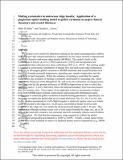| dc.contributor.author | Behn, Mark | |
| dc.contributor.author | Grove, Timothy L. | |
| dc.date.accessioned | 2017-01-19T20:01:29Z | |
| dc.date.available | 2017-01-19T20:01:29Z | |
| dc.date.issued | 2015-07 | |
| dc.date.submitted | 2015-04 | |
| dc.identifier.issn | 2169-9356 | |
| dc.identifier.issn | 2169-9313 | |
| dc.identifier.uri | http://hdl.handle.net/1721.1/106539 | |
| dc.description.abstract | We present a new model for anhydrous melting in the spinel and plagioclase stability fields that provides enhanced predictive capabilities for the major element compositional variability found in mid-ocean ridge basalts (MORBs). The model is built on the formulation of Kinzler and Grove (1992) and Kinzler (1997) but incorporates new experimental data collected since these calibrations. The melting model is coupled to geodynamic simulations of mantle flow and mid-ocean ridge temperature structure to investigate global variations in MORB chemistry and crustal thickness as a function of mantle potential temperature, spreading rate, mantle composition, and the pattern(s) of melt migration. While the initiation of melting is controlled by mantle temperature, the cessation of melting is primarily determined by spreading rate, which controls the thickness of the lithospheric lid, and not by the exhaustion of clinopyroxene. Spreading rate has the greatest influence on MORB compositions at slow to ultraslow spreading rates (<2 cm/yr half rate), where the thermal boundary layer becomes thicker than the oceanic crust. A key aspect of our approach is that we incorporate evidence from both MORB major element compositions and seismically determined crustal thicknesses to constrain global variations in mantle melting parameters. Specifically, we show that to explain the global data set of crustal thickness, Na[subscript 8], Fe[subscript 8], Si[subscript 8], Ca[subscript 8]/Al[subscript 8], and K[subscript 8]/Ti[subscript 8] (oxides normalized to 8 wt % MgO) require a relatively narrow zone over which melts are pooled to the ridge axis. In all cases, our preferred model involves melt transport to the ridge axis over relatively short horizontal length scales (~25 km). This implies that although melting occurs over a wide region beneath the ridge axis, up to 20–40% of the total melt volume is not extracted and will eventually refreeze and refertilize the lithosphere. We find that the temperature range required to explain the global geochemical and geophysical data sets is 1300°C to 1450°C. Finally, a small subset of the global data is best modeled as melts of a depleted mantle source composition (e.g., depleted MORB mantle—2% melt). | en_US |
| dc.description.sponsorship | National Science Foundation (U.S.) (grant OCE01458201) | en_US |
| dc.description.sponsorship | National Science Foundation (U.S.) (grant OCE01457916) | en_US |
| dc.language.iso | en_US | |
| dc.publisher | American Geophysical Union (AGU)/Wiley | en_US |
| dc.relation.isversionof | http://dx.doi.org/10.1002/2015JB011885 | en_US |
| dc.rights | Creative Commons Attribution-Noncommercial-Share Alike | en_US |
| dc.rights.uri | http://creativecommons.org/licenses/by-nc-sa/4.0/ | en_US |
| dc.source | Other repository | en_US |
| dc.title | Melting systematics in mid-ocean ridge basalts: Application of a plagioclase-spinel melting model to global variations in major element chemistry and crustal thickness | en_US |
| dc.type | Article | en_US |
| dc.identifier.citation | Behn, Mark D., and Timothy L. Grove. “Melting Systematics in Mid-Ocean Ridge Basalts: Application of a Plagioclase-Spinel Melting Model to Global Variations in Major Element Chemistry and Crustal Thickness.” Journal of Geophysical Research: Solid Earth vol. 120, no. 7, 2015, pp. 4863–4886. | en_US |
| dc.contributor.department | Massachusetts Institute of Technology. Department of Earth, Atmospheric, and Planetary Sciences | en_US |
| dc.contributor.department | Woods Hole Oceanographic Institution | en_US |
| dc.contributor.mitauthor | Behn, Mark | |
| dc.contributor.mitauthor | Grove, Timothy L | |
| dc.relation.journal | Journal of Geophysical Research: Solid Earth | en_US |
| dc.eprint.version | Author's final manuscript | en_US |
| dc.type.uri | http://purl.org/eprint/type/JournalArticle | en_US |
| eprint.status | http://purl.org/eprint/status/PeerReviewed | en_US |
| dspace.orderedauthors | Behn, Mark D.; Grove, Timothy L. | en_US |
| dspace.embargo.terms | N | en_US |
| dc.identifier.orcid | https://orcid.org/0000-0001-9998-270X | |
| mit.license | OPEN_ACCESS_POLICY | en_US |
